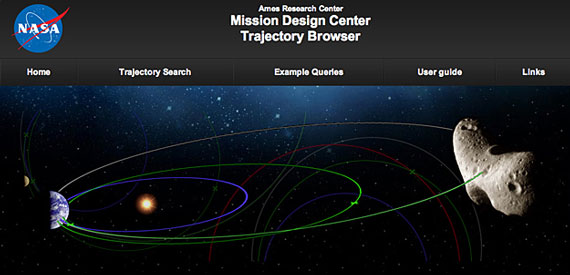| Mar 05, 2013 |
NASA launches interactive website to design interplanetary missions
|
|
(Nanowerk News) A small group of engineers at NASA's Ames Research Center, Moffett Field, Calif., have launched a new web-based tool for scientists and engineers to use when designing spacecraft trajectories to interplanetary destinations.
|
|
The Trajectory Browser, as the web application is called, can provide an instantaneous assessment of the launch date, time and flight path requirements for future missions to asteroids, comets and planets for the next 25 years.
|
 |
| Trajectory Browser website
|
|
"The Trajectory Browser website is best used as a first-cut tool to assess the existence of trajectories to small bodies and planets and provide ball-park values on launch date, duration and trajectory requirements," said Cyrus Foster, an aerospace engineer at the NASA Ames Mission Design Center and lead developer of the Trajectory Browser. "The website is flexible enough to provide information about various types of missions such as rendezvous, sample return or flybys and is routinely updated with the latest asteroid and comet discoveries made by astronomers and NASA missions."
|
|
After specifying the destination, a user then enters whether the mission will be one-way or round-trip, and include a flyby or rendezvous of the destination. In a similar fashion to internet search engines, the user can press "search" and view a list of suitable trajectories highlighting their detailed requirements, such as launch energy, mission duration, and a visual "travel itinerary" that specifies all the critical events of that trajectory. An animation tool then lets the user follow the relative movements of the spacecraft, Earth and destination from launch to arrival.
|
|
For example, users can find a trajectory to rendezvous a spacecraft with the 150-feet in diameter asteroid 2012DA14, which passed close, but safely, by Earth on Friday, Feb. 15, 2013. According to calculations by the Trajectory Browser tool, a spacecraft could be launched to rendezvous with 2012DA14 on Feb. 24, 2014, Feb. 19, 2018 and again on Feb. 22, 2019. To view an example of these trajectories, visit: http://go.nasa.gov/Z5ZSB3
|
|
NASA's Near Earth Object Program and the HORIZONS system managed by NASA's Jet Propulsion Laboratory, Pasadena, Calif., acquire asteroid and comet observation data from various sources and generate the trajectories for these asteroids. The Trajectory Browser uses these asteroid trajectories and computes a potential spacecraft trajectory launching from Earth.
|
|
In 2016, NASA is scheduled to launch the Origins-Spectral Interpretation-Resource Identification-Security-Regolith Explorer mission or OSIRIS-REx to an asteroid called 1999 RQ36. The mission will mark the first U.S. project to return asteroid samples to Earth for analysis. OSIRIS-REx will be a pathfinder for future spacecraft designed to perform reconnaissance on any newly-discovered threatening objects.
|
|
Trajectory Browser requires an HTML5-compatible browser such as Internet Explorer 9, Firefox 3.6+, Safari 3.2+, Chrome 11+ or Opera 10.6+ with Javascript enabled.
|

